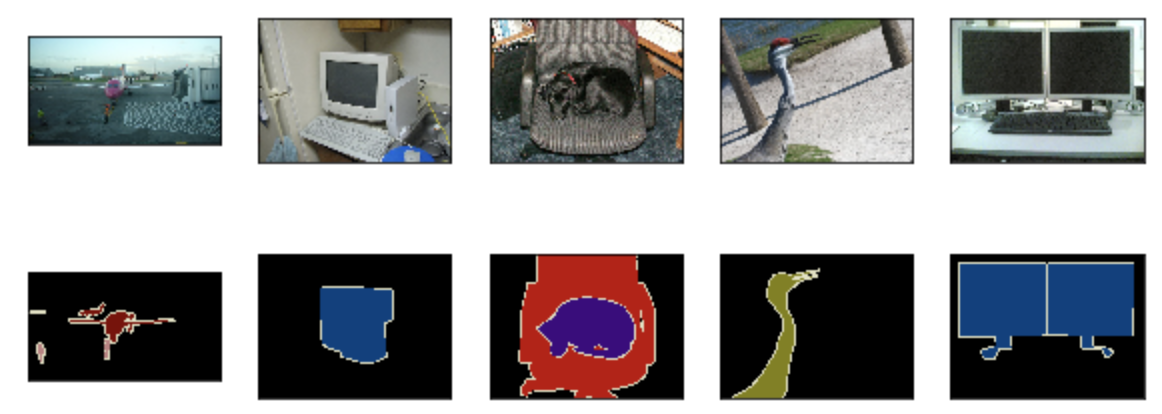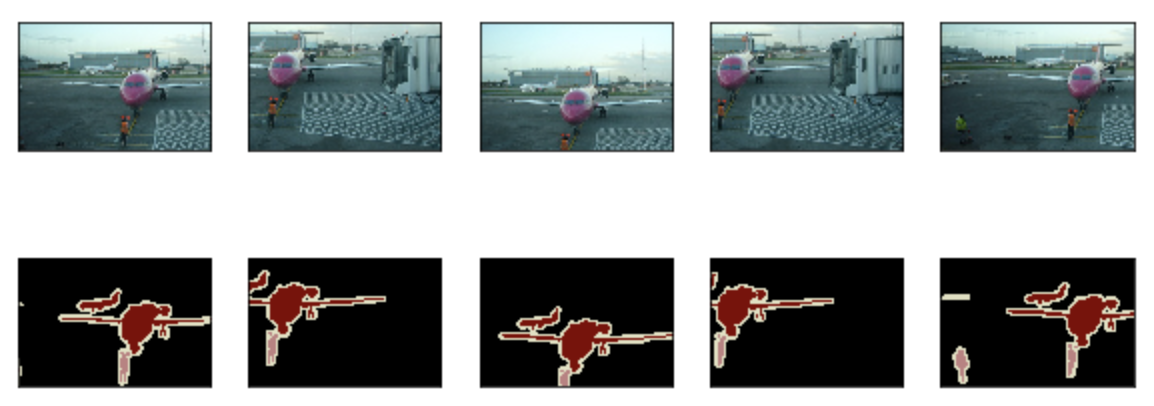在前几节讨论的目标检测问题中,我们一直使用方形边界框来标注和预测图像中的目标。本节将探讨语义分割(semantic segmentation)问题,它关注如何将图像分割成属于不同语义类别的区域。值得一提的是,这些语义区域的标注和预测都是像素级的。图9.10展示了语义分割中图像有关狗、猫和背景的标签。可以看到,与目标检测相比,语义分割标注的像素级的边框显然更加精细。

9.9.1 图像分割和实例分割
计算机视觉领域还有2个与语义分割相似的重要问题,即图像分割(image segmentation)和实例分割(instance segmentation)。我们在这里将它们与语义分割简单区分一下。
- 图像分割将图像分割成若干组成区域。这类问题的方法通常利用图像中像素之间的相关性。它在训练时不需要有关图像像素的标签信息,在预测时也无法保证分割出的区域具有我们希望得到的语义。以图9.10的图像为输入,图像分割可能将狗分割成两个区域:一个覆盖以黑色为主的嘴巴和眼睛,而另一个覆盖以黄色为主的其余部分身体。
- 实例分割又叫同时检测并分割(simultaneous detection and segmentation)。它研究如何识别图像中各个目标实例的像素级区域。与语义分割有所不同,实例分割不仅需要区分语义,还要区分不同的目标实例。如果图像中有两只狗,实例分割需要区分像素属于这两只狗中的哪一只。
9.9.2 Pascal VOC2012语义分割数据集
语义分割的一个重要数据集叫作Pascal VOC2012 [1]。为了更好地了解这个数据集,我们先导入实验所需的包或模块。
%matplotlib inlineimport timeimport torchimport torch.nn.functional as Fimport torchvisionimport numpy as npfrom PIL import Imagefrom tqdm import tqdmimport syssys.path.append("..")import d2lzh_pytorch as d2l
我们先下载这个数据集的压缩包(下载地址)。压缩包大小是2 GB左右,下载需要一定时间。下载后解压得到VOCdevkit/VOC2012文件夹,然后将其放置在data文件夹下。
!ls ../../data/VOCdevkit/VOC2012
Annotations JPEGImages SegmentationObjectImageSets SegmentationClass
进入../../data/VOCdevkit/VOC2012路径后,我们可以获取数据集的不同组成部分。其中ImageSets/Segmentation路径包含了指定训练和测试样本的文本文件,而JPEGImages和SegmentationClass路径下分别包含了样本的输入图像和标签。这里的标签也是图像格式,其尺寸和它所标注的输入图像的尺寸相同。标签中颜色相同的像素属于同一个语义类别。下面定义read_voc_images函数将输入图像和标签读进内存。
# 本函数已保存在d2lzh_pytorch中方便以后使用def read_voc_images(root="../../data/VOCdevkit/VOC2012",is_train=True, max_num=None):txt_fname = '%s/ImageSets/Segmentation/%s' % (root, 'train.txt' if is_train else 'val.txt')with open(txt_fname, 'r') as f:images = f.read().split()if max_num is not None:images = images[:min(max_num, len(images))]features, labels = [None] * len(images), [None] * len(images)for i, fname in tqdm(enumerate(images)):features[i] = Image.open('%s/JPEGImages/%s.jpg' % (root, fname)).convert("RGB")labels[i] = Image.open('%s/SegmentationClass/%s.png' % (root, fname)).convert("RGB")return features, labels # PIL imagevoc_dir = "../../data/VOCdevkit/VOC2012"train_features, train_labels = read_voc_images(voc_dir, max_num=100)
我们画出前5张输入图像和它们的标签。在标签图像中,白色和黑色分别代表边框和背景,而其他不同的颜色则对应不同的类别。
n = 5imgs = train_features[0:n] + train_labels[0:n]d2l.show_images(imgs, 2, n);

接下来,我们列出标签中每个RGB颜色的值及其标注的类别。
# 本函数已保存在d2lzh_pytorch中方便以后使用VOC_COLORMAP = [[0, 0, 0], [128, 0, 0], [0, 128, 0], [128, 128, 0],[0, 0, 128], [128, 0, 128], [0, 128, 128], [128, 128, 128],[64, 0, 0], [192, 0, 0], [64, 128, 0], [192, 128, 0],[64, 0, 128], [192, 0, 128], [64, 128, 128], [192, 128, 128],[0, 64, 0], [128, 64, 0], [0, 192, 0], [128, 192, 0],[0, 64, 128]]# 本函数已保存在d2lzh_pytorch中方便以后使用VOC_CLASSES = ['background', 'aeroplane', 'bicycle', 'bird', 'boat','bottle', 'bus', 'car', 'cat', 'chair', 'cow','diningtable', 'dog', 'horse', 'motorbike', 'person','potted plant', 'sheep', 'sofa', 'train', 'tv/monitor']
有了上面定义的两个常量以后,我们可以很容易地查找标签中每个像素的类别索引。
colormap2label = torch.zeros(256 ** 3, dtype=torch.uint8)for i, colormap in enumerate(VOC_COLORMAP):colormap2label[(colormap[0] * 256 + colormap[1]) * 256 + colormap[2]] = i# 本函数已保存在d2lzh_pytorch中方便以后使用def voc_label_indices(colormap, colormap2label):"""convert colormap (PIL image) to colormap2label (uint8 tensor)."""colormap = np.array(colormap.convert("RGB")).astype('int32')idx = ((colormap[:, :, 0] * 256 + colormap[:, :, 1]) * 256+ colormap[:, :, 2])return colormap2label[idx]
例如,第一张样本图像中飞机头部区域的类别索引为1,而背景全是0。
y = voc_label_indices(train_labels[0], colormap2label)y[105:115, 130:140], VOC_CLASSES[1]
输出:
(tensor([[0, 0, 0, 0, 0, 0, 0, 0, 0, 1],[0, 0, 0, 0, 0, 0, 0, 1, 1, 1],[0, 0, 0, 0, 0, 0, 1, 1, 1, 1],[0, 0, 0, 0, 0, 1, 1, 1, 1, 1],[0, 0, 0, 0, 0, 1, 1, 1, 1, 1],[0, 0, 0, 0, 1, 1, 1, 1, 1, 1],[0, 0, 0, 0, 0, 1, 1, 1, 1, 1],[0, 0, 0, 0, 0, 1, 1, 1, 1, 1],[0, 0, 0, 0, 0, 0, 1, 1, 1, 1],[0, 0, 0, 0, 0, 0, 0, 0, 1, 1]], dtype=torch.uint8), 'aeroplane')
9.9.2.1 预处理数据
在之前的章节中,我们通过缩放图像使其符合模型的输入形状。然而在语义分割里,这样做需要将预测的像素类别重新映射回原始尺寸的输入图像。这样的映射难以做到精确,尤其在不同语义的分割区域。为了避免这个问题,我们将图像裁剪成固定尺寸而不是缩放。具体来说,我们使用图像增广里的随机裁剪,并对输入图像和标签裁剪相同区域。
# 本函数已保存在d2lzh_pytorch中方便以后使用def voc_rand_crop(feature, label, height, width):"""Random crop feature (PIL image) and label (PIL image)."""i, j, h, w = torchvision.transforms.RandomCrop.get_params(feature, output_size=(height, width))feature = torchvision.transforms.functional.crop(feature, i, j, h, w)label = torchvision.transforms.functional.crop(label, i, j, h, w)return feature, labelimgs = []for _ in range(n):imgs += voc_rand_crop(train_features[0], train_labels[0], 200, 300)d2l.show_images(imgs[::2] + imgs[1::2], 2, n);
9.9.2.2 自定义语义分割数据集类
我们通过继承PyTorch提供的Dataset类自定义了一个语义分割数据集类VOCSegDataset。通过实现__getitem__函数,我们可以任意访问数据集中索引为idx的输入图像及其每个像素的类别索引。由于数据集中有些图像的尺寸可能小于随机裁剪所指定的输出尺寸,这些样本需要通过自定义的filter函数所移除。此外,我们还对输入图像的RGB三个通道的值分别做标准化。
# 本函数已保存在d2lzh_pytorch中方便以后使用class VOCSegDataset(torch.utils.data.Dataset):def __init__(self, is_train, crop_size, voc_dir, colormap2label, max_num=None):"""crop_size: (h, w)"""self.rgb_mean = np.array([0.485, 0.456, 0.406])self.rgb_std = np.array([0.229, 0.224, 0.225])self.tsf = torchvision.transforms.Compose([torchvision.transforms.ToTensor(),torchvision.transforms.Normalize(mean=self.rgb_mean,std=self.rgb_std)])self.crop_size = crop_size # (h, w)features, labels = read_voc_images(root=voc_dir,is_train=is_train,max_num=max_num)self.features = self.filter(features) # PIL imageself.labels = self.filter(labels) # PIL imageself.colormap2label = colormap2labelprint('read ' + str(len(self.features)) + ' valid examples')def filter(self, imgs):return [img for img in imgs if (img.size[1] >= self.crop_size[0] andimg.size[0] >= self.crop_size[1])]def __getitem__(self, idx):feature, label = voc_rand_crop(self.features[idx], self.labels[idx],*self.crop_size)return (self.tsf(feature), # float32 tensorvoc_label_indices(label, self.colormap2label)) # uint8 tensordef __len__(self):return len(self.features)
9.9.2.3 读取数据集
我们通过自定义的VOCSegDataset类来分别创建训练集和测试集的实例。假设我们指定随机裁剪的输出图像的形状为。下面我们可以查看训练集和测试集所保留的样本个数。
crop_size = (320, 480)max_num = 100voc_train = VOCSegDataset(True, crop_size, voc_dir, colormap2label, max_num)voc_test = VOCSegDataset(False, crop_size, voc_dir, colormap2label, max_num)
输出:
read 75 valid examplesread 77 valid examples
设批量大小为64,分别定义训练集和测试集的迭代器。
batch_size = 64num_workers = 0 if sys.platform.startswith('win32') else 4train_iter = torch.utils.data.DataLoader(voc_train, batch_size, shuffle=True,drop_last=True, num_workers=num_workers)test_iter = torch.utils.data.DataLoader(voc_test, batch_size, drop_last=True,num_workers=num_workers)
打印第一个小批量的类型和形状。不同于图像分类和目标识别,这里的标签是一个三维数组。
for X, Y in train_iter:print(X.dtype, X.shape)print(y.dtype, Y.shape)break
输出:
torch.float32 torch.Size([64, 3, 320, 480])torch.uint8 torch.Size([64, 320, 480])
小结
- 语义分割关注如何将图像分割成属于不同语义类别的区域。
- 语义分割的一个重要数据集叫作Pascal VOC2012。
- 由于语义分割的输入图像和标签在像素上一一对应,所以将图像随机裁剪成固定尺寸而不是缩放。
练习
- 回忆9.1节(图像增广)中的内容。哪些在图像分类中使用的图像增广方法难以用于语义分割?
参考文献
[1] Pascal VOC2012数据集。http://host.robots.ox.ac.uk/pascal/VOC/voc2012/
注:除代码外本节与原书基本相同,原书传送门

